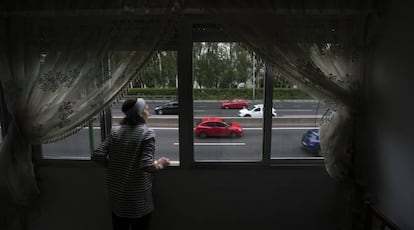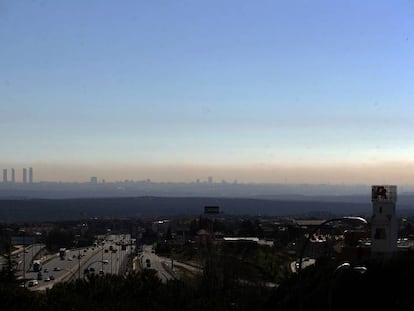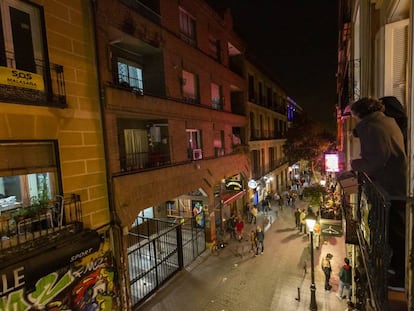Noise pollution: How Spain is fighting to stop a not-so-silent killer
According to the European Environment Agency, the problem causes 16,600 premature deaths and 72,000 hospital admissions a year in Europe

Pollution kills, and not just the kind that can be seen hanging over the city in orange clouds. Noise pollution causes 16,600 premature deaths and 72,000 hospital admissions a year in Europe, according to the European Environment Agency. The main culprit is road traffic – which is also mainly to blame for the carbon dioxide emissions that cause 10,000 premature deaths in Spain a year, according to the World Health Organization (WHO).
I can’t sleep well even when it’s quiet
Barcelona resident Alex Mas
Cardiovascular diseases, hypertension, sleeping disorders, cognitive impairment and tinnitus or deafness, are all diseases directly related to noise pollution. Research has also identified a link between noise and problems during pregnancy, obesity and diabetes. In fact, noise pollution adversely affects almost half the population of Europe during the day and around a third at night.
As with air pollution, it is impossible to determine if an individual case has been caused specifically by noise, given there is usually a number of contributory factors. Consequently, scientists rely on epidemiological analysis of large populations to draw conclusions. But when a person exposed to excessive noise over a prolonged period of time experiences a specific set of symptoms, noise pollution may well be playing an important role.
Alex Mas’s insomnia problems began when he moved to the Plaza del Sol square in Barcelona. “I slept like a log all my life,” he says. “That changed when I moved here, there was a ‘click’; now I can’t sleep well even when it’s quiet.”
Alex is one of 13 million Europeans who suffer from sleep disorders due to excessive noise. “From that point on, due also to an intense job, I developed stress and anxiety,” he says.
The manner in which noise pollution affects our health is becoming increasingly recognized. Julio Díaz, head of the Department of Epidemiology at the Carlos III Health Institute’s National School of Health, explains that the body experiences noise as an aggression: “What you try to do is to repel it and in order for that to happen the muscles need energy, which in turn increases the blood pressure and heart rate so that more oxygen can reach [the muscles],” he says, adding that this would be the cause of heart problems and hypertension.
According to Díaz’s research, hospital admissions increase on the back of noise peaks
“More glucose is also generated to provide this energy, but as it is a fictional aggression, it is not properly eliminated,” he says. According to Díaz, this explains the relationship with diabetes and obesity. “For all this to happen, cortisol is needed. There are studies that show that high levels of this substance lower the immune system. Thus, a controllable infection can cease to be controllable,” he says to explain how excessive noise can contribute to respiratory diseases.
According to Díaz, research has found that a child who is put in a noisy room has a much higher level of cortisol in their saliva than a child who is put in a silent room. “This has a clear impact on health,” he says.
In October 2018, the WHO published a new guide on noise based on scientific studies that lowered the threshold of what is considered to be safe exposure to noise. It recommends levels below 53 decibels during the day and 45 decibels at night with regard to road traffic, which is the most common source of noise pollution. “The problem in Spain is that we do not have long-term studies,” explains Díaz. His team has done several short-term studies in Madrid, which show that hospital admissions increase on the back of noise peaks just as they do with exposure to peaks in emissions from traffic.
“We have confirmed that [hospital admissions] increased for circulatory and respiratory issues in the year 2000; then, in 2007, when more children were admitted, in particular for pneumonia. And, in 2014, we have confirmed that it [noise] is capable of triggering more admissions for cardiovascular problems and diabetes, and we will see if it also causes deaths,” he says.
Noise pollution in Europe
Exposure to noise in Europe:
Some 40% of Europe’s population is exposed to daytime noise levels from road traffic exceeding 55 decibels (dB); while 20% are exposed to levels over 65 dB. At night, more than 30% are exposed to levels above 55 dB.
People affected
13 million people experience disturbed sleep.
72,000 are admitted to hospital annually.
16,600 die prematurely every year.
Associated diseases
Stress, sleep disorder, behavioral disturbance and debilitated performance, hypertension and heart disease. Possibly diabetes and obesity.
WHO recommendations on noise exposure
Traffic: less than 53 dB during the day and 45 dB at night.
Trains: less than 54 dB during the day and 44 dB at night.
Airplanes: Less than 45 dB during the day and 49 dB at night.
Noise caused by leisure: less than 70 dB.
María Foraster, one of the authors of the WHO guide and a researcher at the ISGlobal health institute, financed by the LaCaixa Foundation, explains that new studies – such as the noise maps that municipalities with populations of more than 100,000 have to publish every five years – will bring more accurate data. She adds that reducing noise means reducing the traffic in cities: “There is a double advantage, because this also stops air pollution,” she says.
“Ideally, we would plan cities where there are no urban areas near roads used by cars, cities where there are quiet spaces. In those areas that already exist, barriers can be put up, preferably natural ones, as these are more beneficial, but it is not always easy.” Foraster supports initiatives such as the low-emissions zone Madrid Central, which made 472 hectares of the city center off-limits to traffic, apart from local residents and public transportation, and the plan to create supermanzanas, or mega residential blocks, in Barcelona.
The Barcelona urban initiative consists of cutting traffic from entire blocks, or restricting it as far as possible, so that only residents are allowed access. This would allow more space for sports and recreational areas. An ISGlobal study in Barcelona estimated that the city could save up to €20 million annually in healthcare with this type of infrastructure.
In Barcelona’s Plaza del Sol square, where Alex Mas lives, the locals have been complaining about the noise for years. The Ideas For Change organization came up with a pilot to measure noise pollution and find solutions. After studying the situation, they put forward four suggestions: putting plants on the city’s steps to prevent people from loitering on them; building playgrounds to encourage an alternative use of space; increasing the presence of the local police; and improving information about the problems caused by outdoor partying. Nothing official has yet been published on the success of these initiatives. Neighbors maintain they continue to lose sleep – and possibly health – on account of the noise.
English version by Heather Galloway.
Tu suscripción se está usando en otro dispositivo
¿Quieres añadir otro usuario a tu suscripción?
Si continúas leyendo en este dispositivo, no se podrá leer en el otro.
FlechaTu suscripción se está usando en otro dispositivo y solo puedes acceder a EL PAÍS desde un dispositivo a la vez.
Si quieres compartir tu cuenta, cambia tu suscripción a la modalidad Premium, así podrás añadir otro usuario. Cada uno accederá con su propia cuenta de email, lo que os permitirá personalizar vuestra experiencia en EL PAÍS.
¿Tienes una suscripción de empresa? Accede aquí para contratar más cuentas.
En el caso de no saber quién está usando tu cuenta, te recomendamos cambiar tu contraseña aquí.
Si decides continuar compartiendo tu cuenta, este mensaje se mostrará en tu dispositivo y en el de la otra persona que está usando tu cuenta de forma indefinida, afectando a tu experiencia de lectura. Puedes consultar aquí los términos y condiciones de la suscripción digital.
More information
Archived In
Últimas noticias
Most viewed
- Reinhard Genzel, Nobel laureate in physics: ‘One-minute videos will never give you the truth’
- Oona Chaplin: ‘I told James Cameron that I was living in a treehouse and starting a permaculture project with a friend’
- Pablo Escobar’s hippos: A serious environmental problem, 40 years on
- Charles Dubouloz, mountaineering star, retires at 36 with a farewell tour inspired by Walter Bonatti
- Why we lost the habit of sleeping in two segments and how that changed our sense of time











































